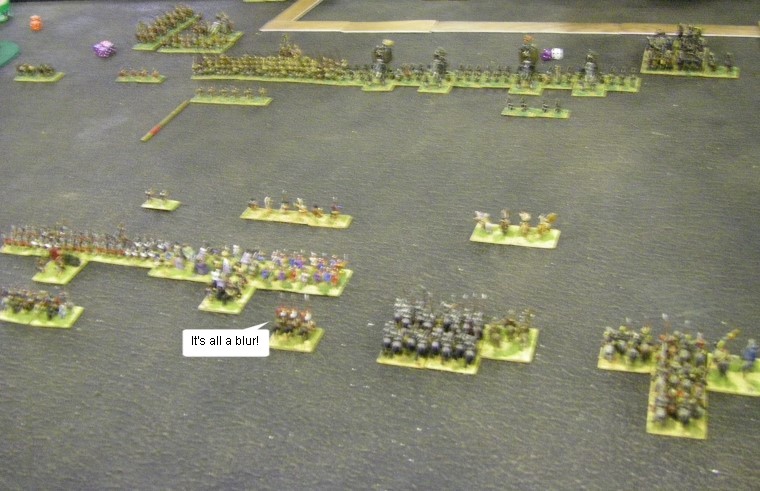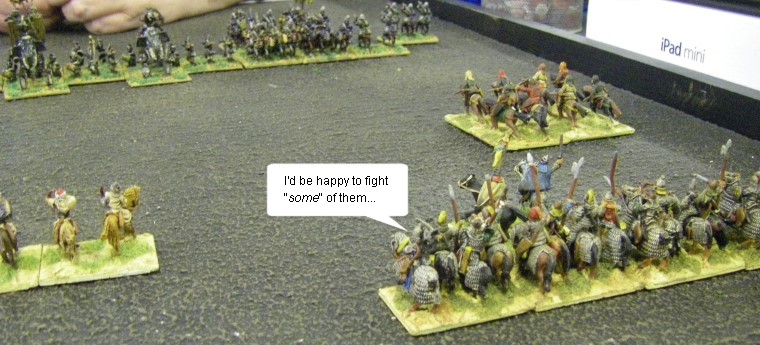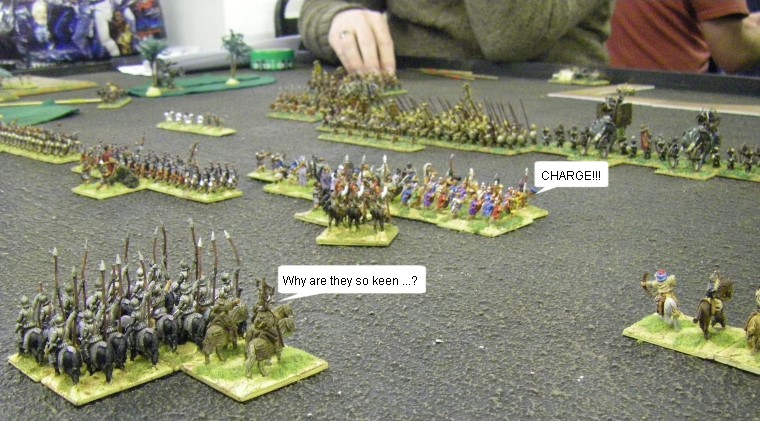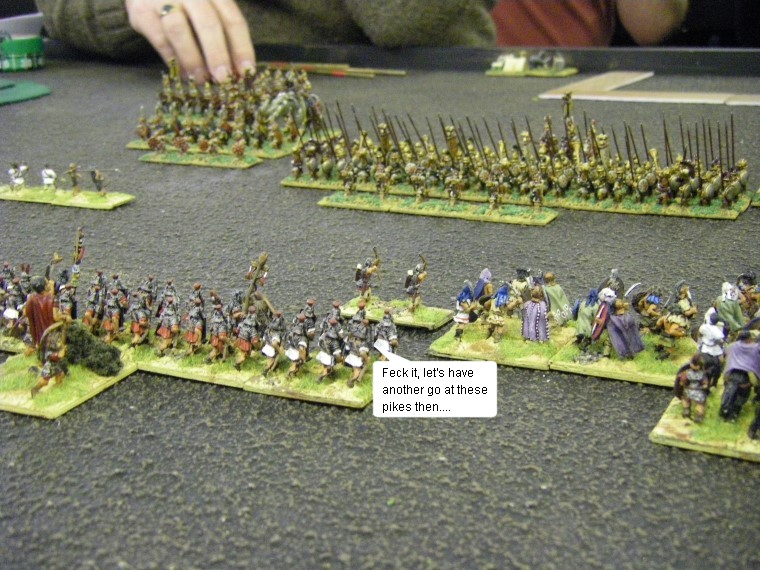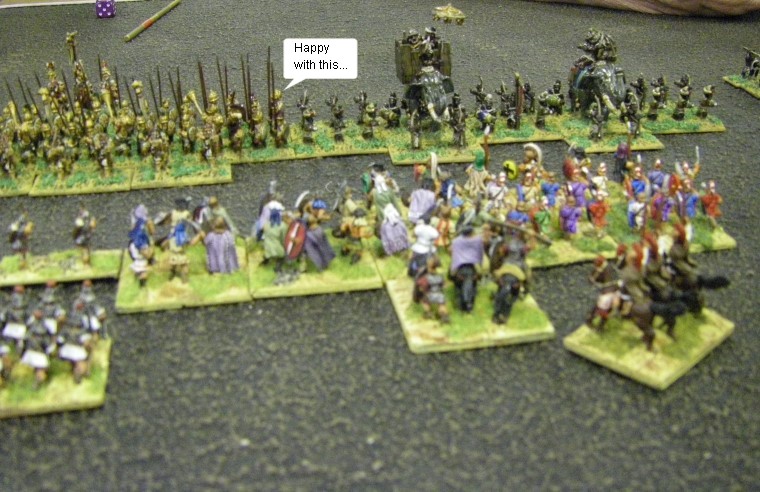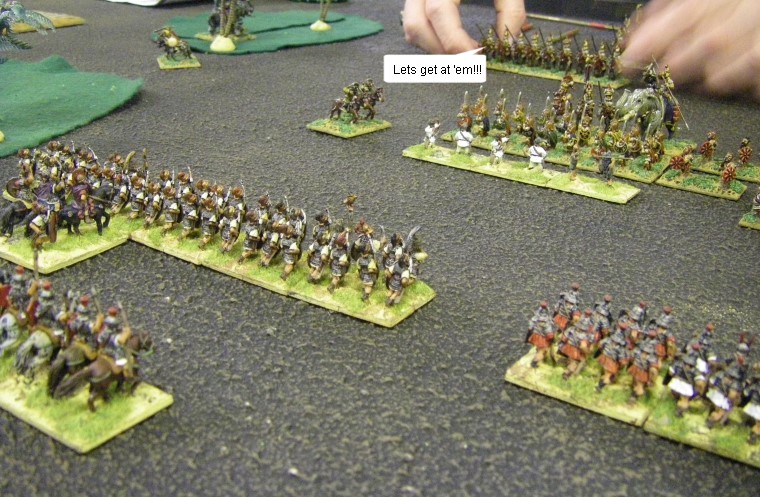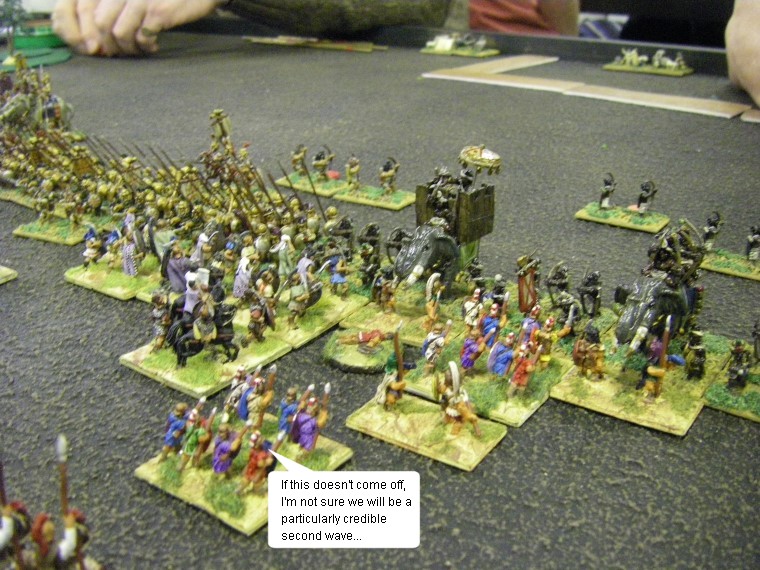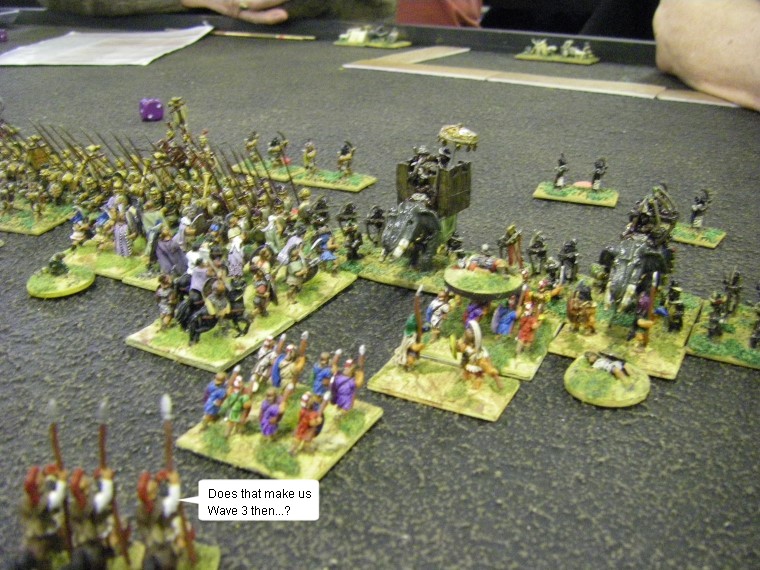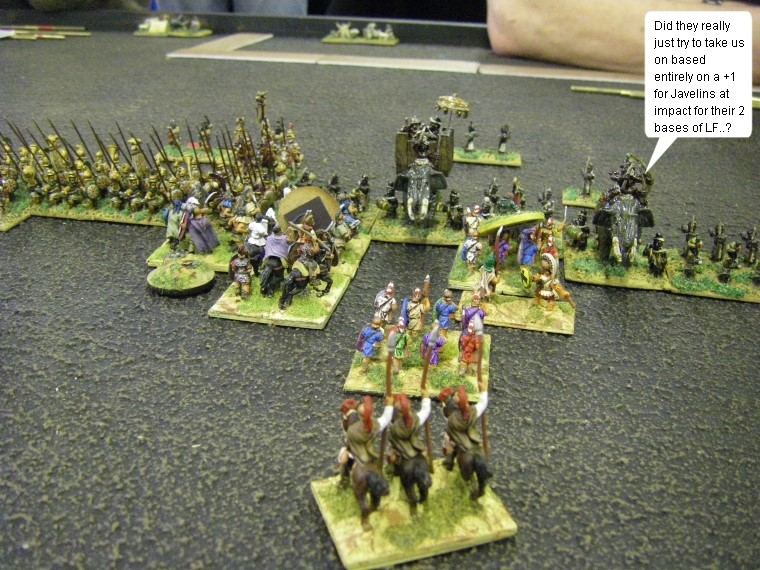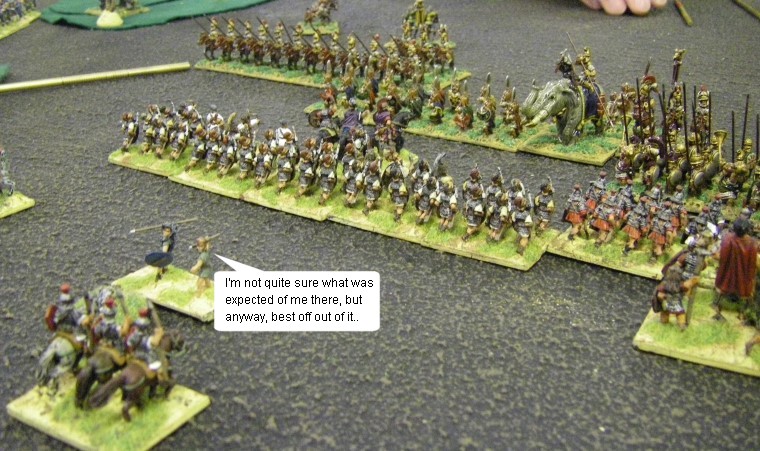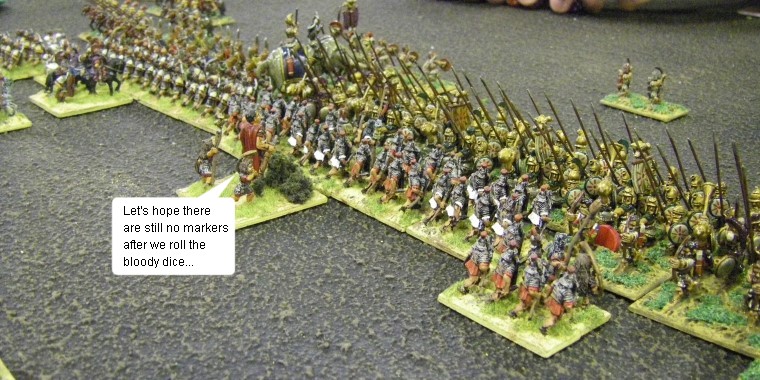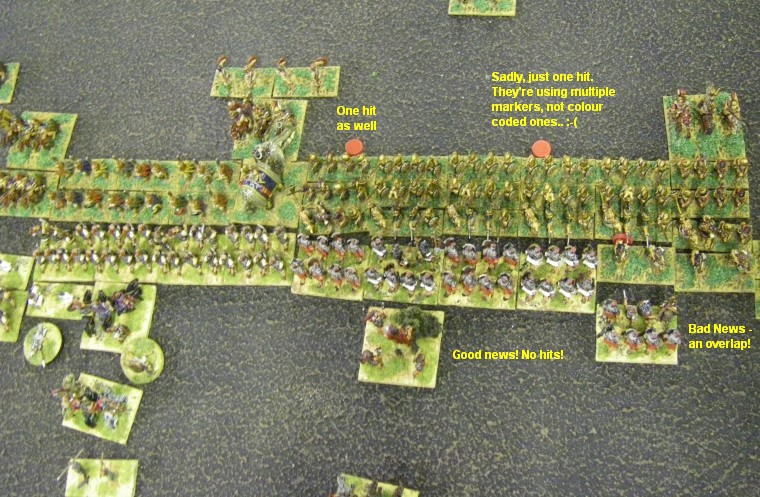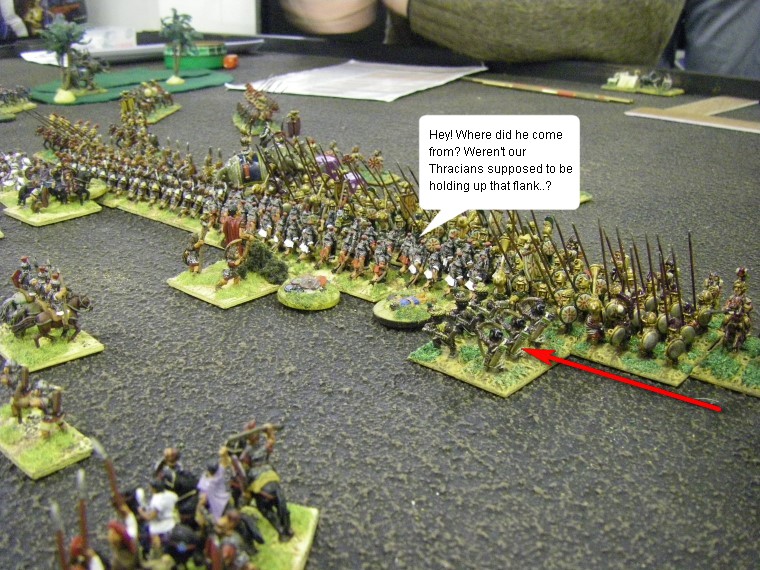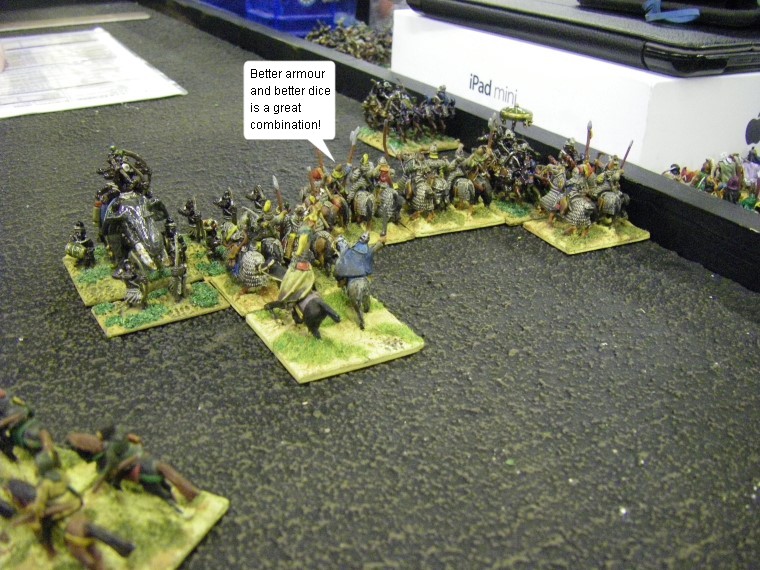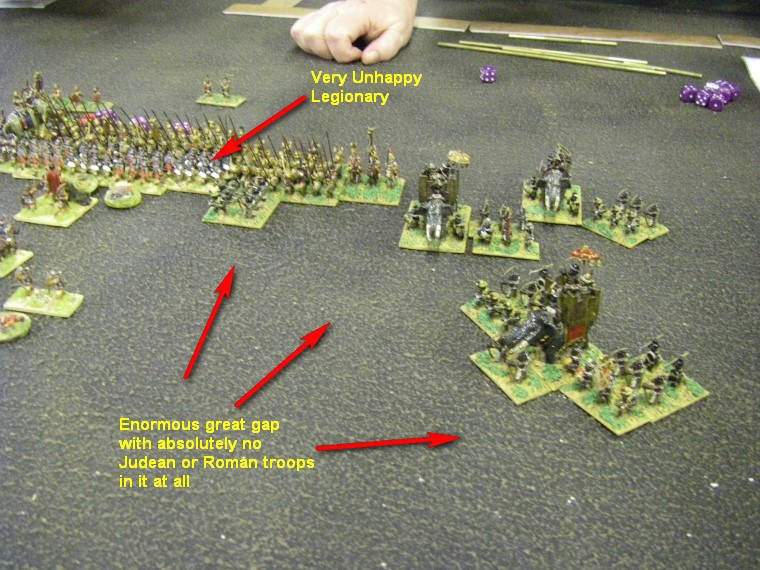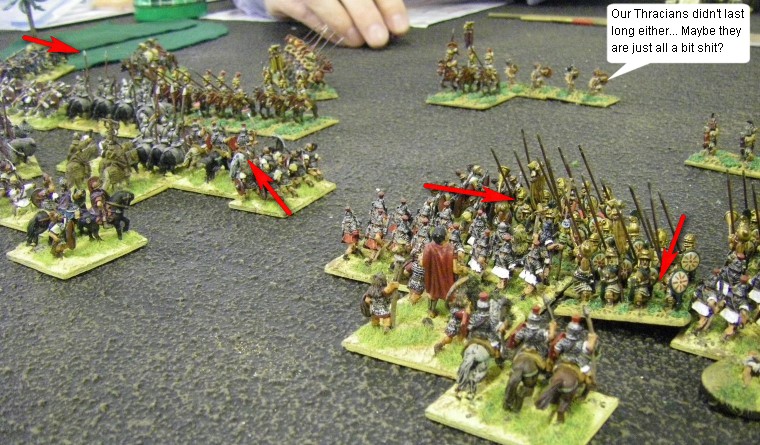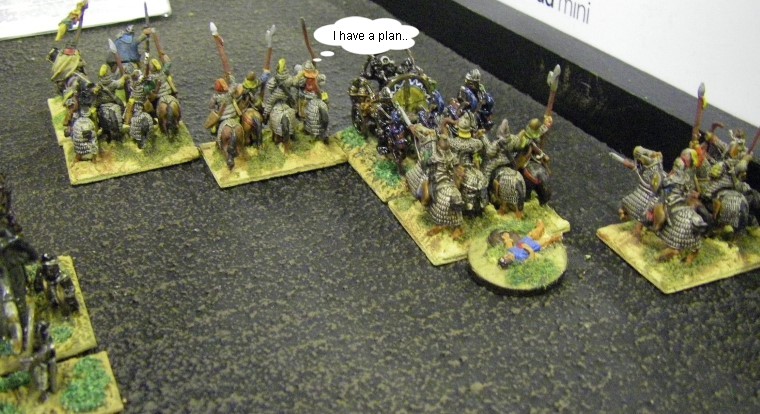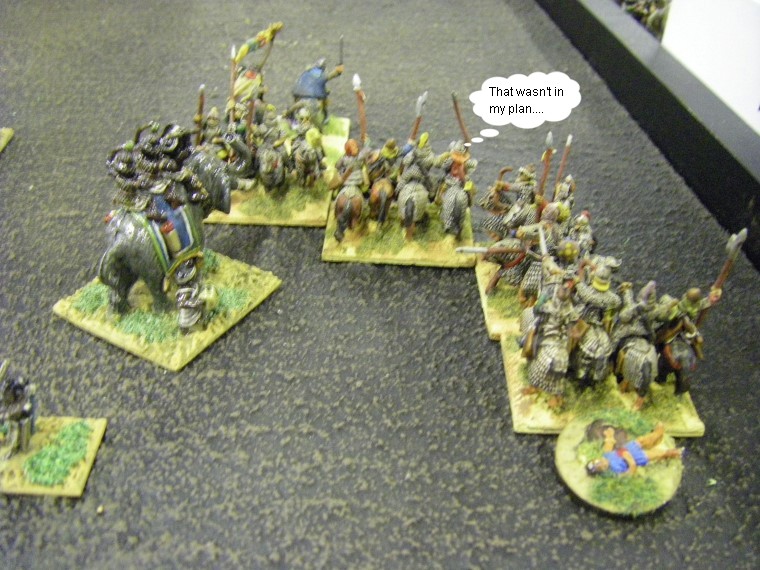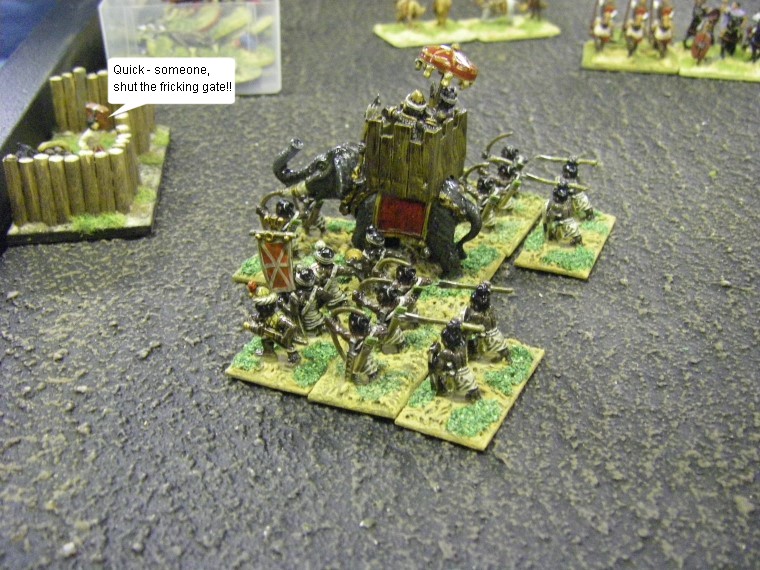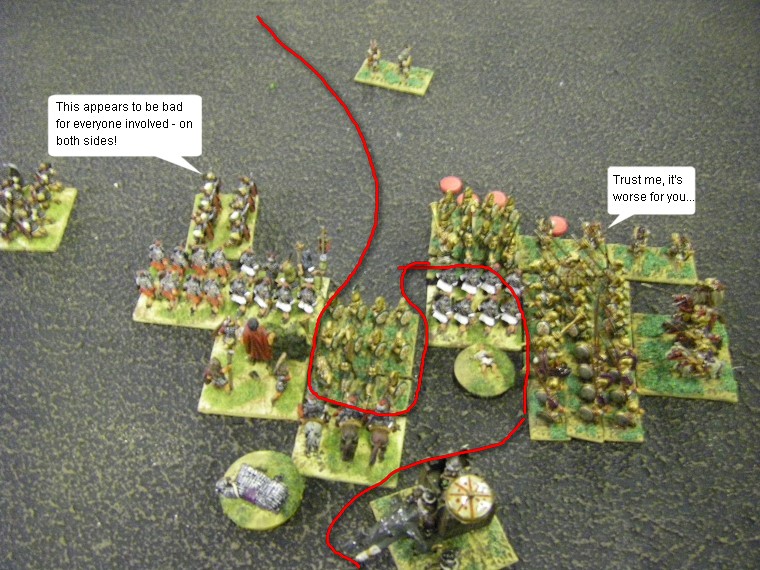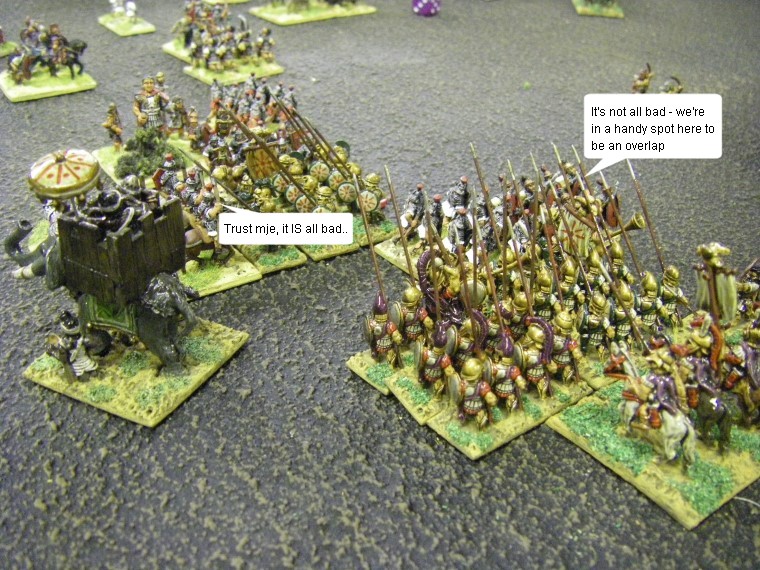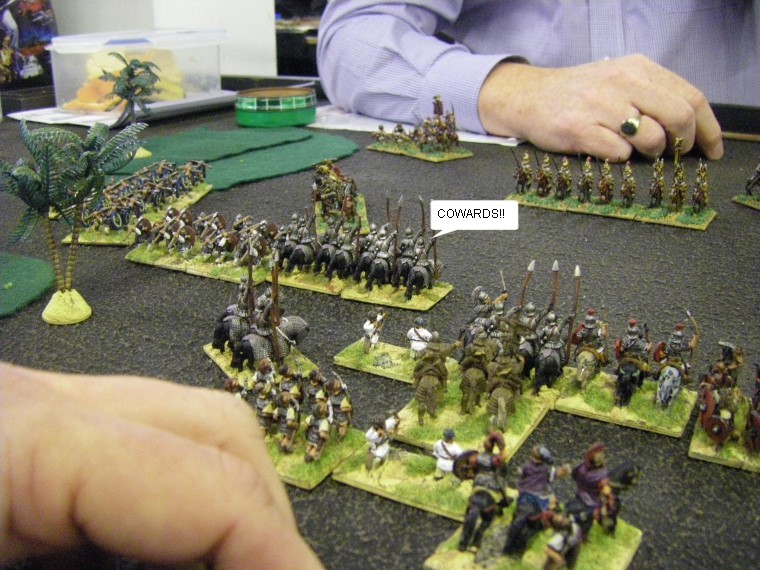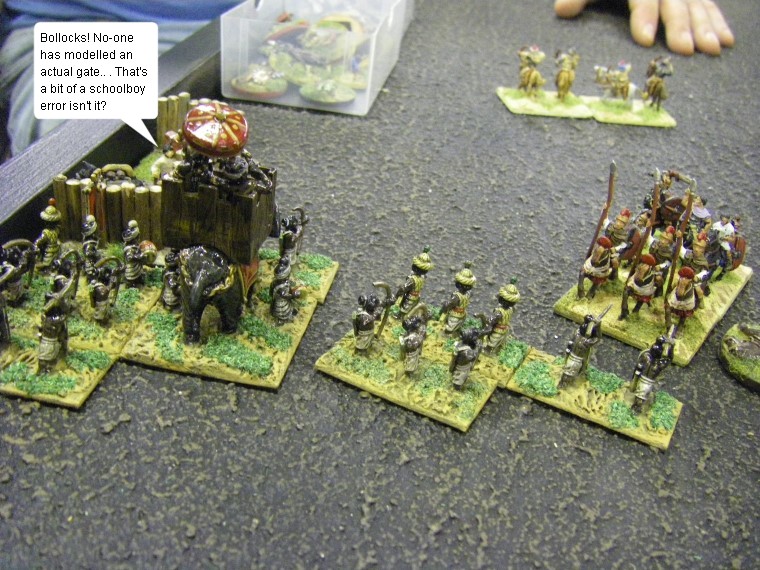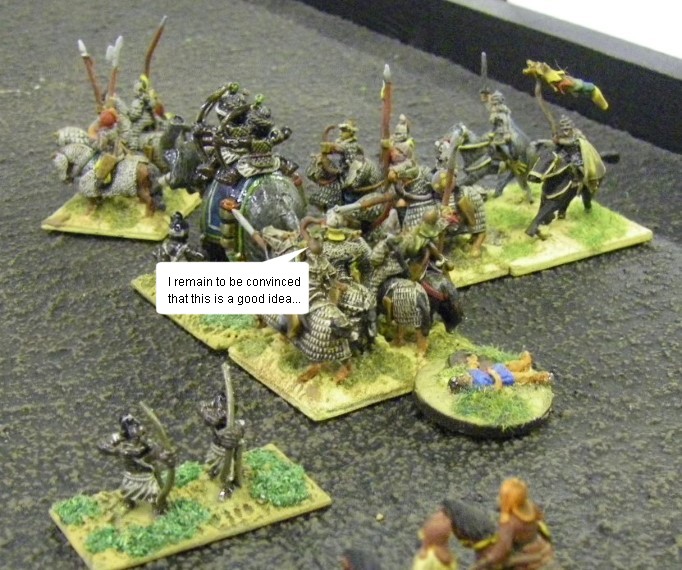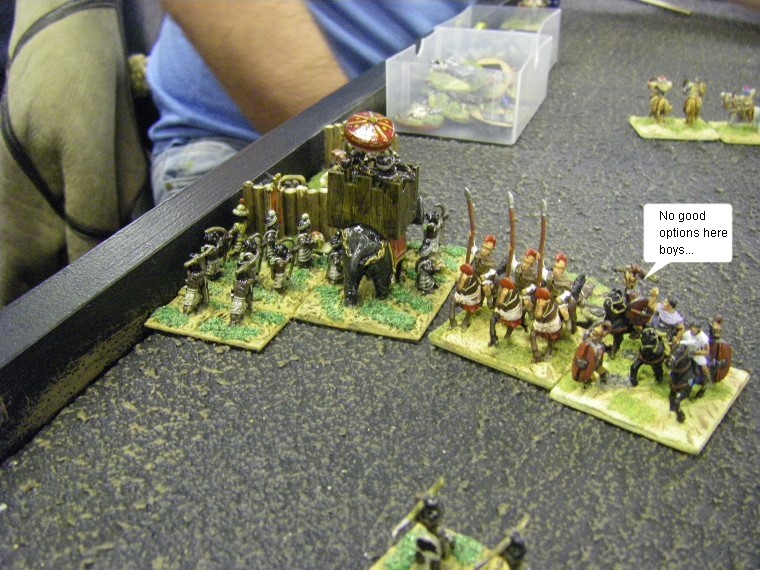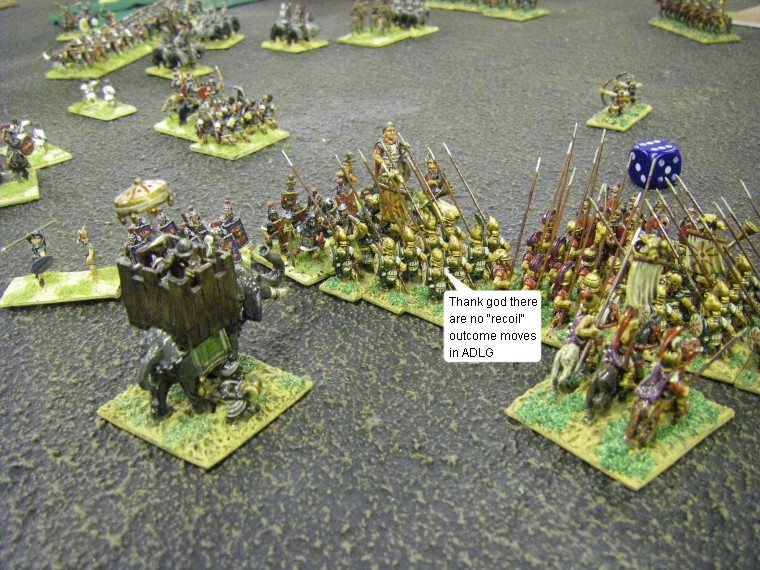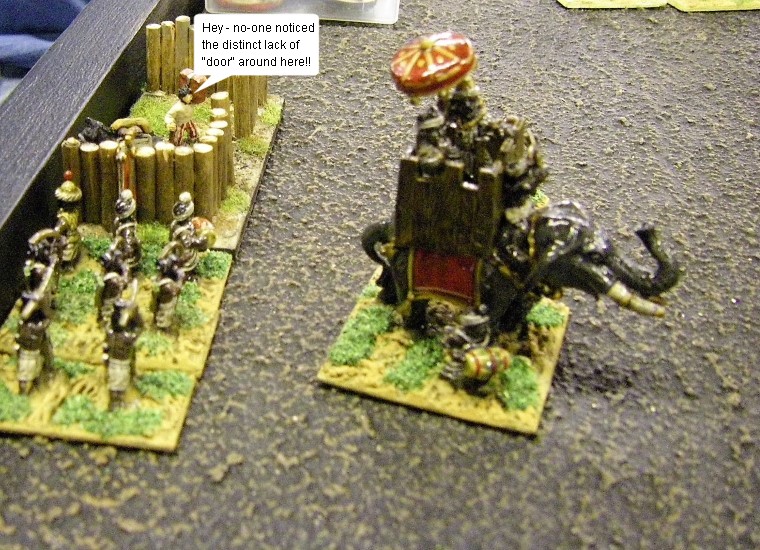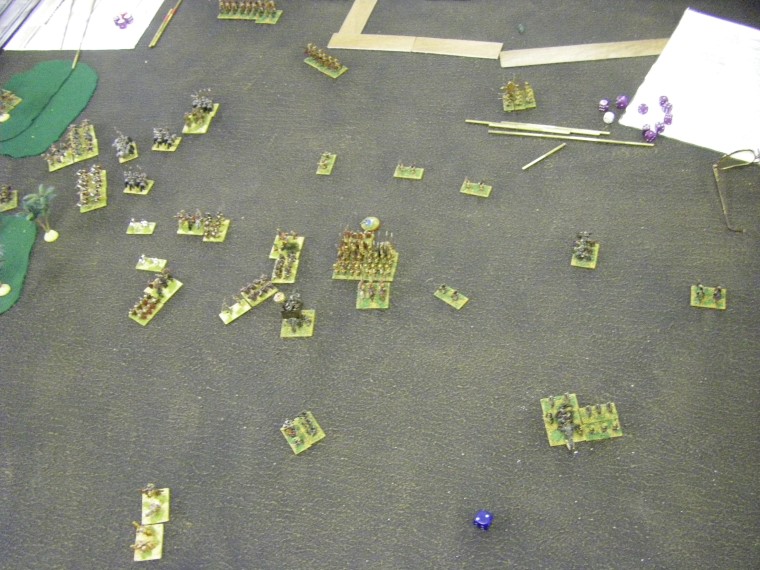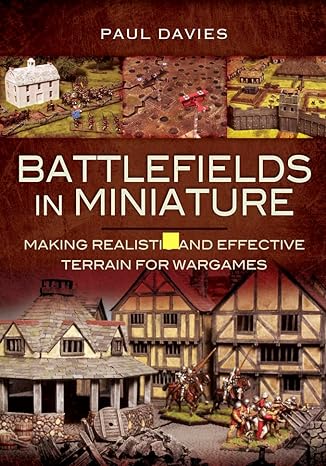Biblical &Classical in Godendag 2017
Early Imperial Roman & Judean vs Alexander the Great and Classical Indian
Game 1 Early Imperial Roman & Judean vs Chinese Northern Dynasties & Chi'ang
Game 2 Early Imperial Roman & Judean vs Ostrogoths and Gepids
Game 3 Early Imperial Roman & Judean vs Greco-Indians and Kushans
Game 4 Early Imperial Roman & Judean vs Alexander the Great and Classical Indian
So, we lurch on into the afternoon session, tucked in behind the leaders ample frames and sustained by a heated roll from the nearby station concourse. Covering the short byt rain-soaked distance from the venue to the station, we saw many Welsh Thing Happening. And when we returned the afternoon had in prospect the Don!
The Don
Alexander the Great and Classical Indian was another textbook combination - the same army as the morning, but with less Cataphracts and more Pikes, Elephants and high quality lancer cavalry. . The lists for the Early Imperial Roman & Judean and Alexander the Great and Classical Indian from this game, as well as all the other lists from the games at Godendag can be seen here in the L'Art de la Guerre Wiki.
The terrain had largely fallen on our left flank, creating a nice flat historical plain for the 4 armies to square off across. The Judeo-Roman alliance had set up much as in the previous game with a centre of Peltasts, both units of Legions on the left with the Auxilia beyond them and both cataphract commands on the right. Greece faced the Legions, and India faced the Cataphracts.
What's Going on Here Then?
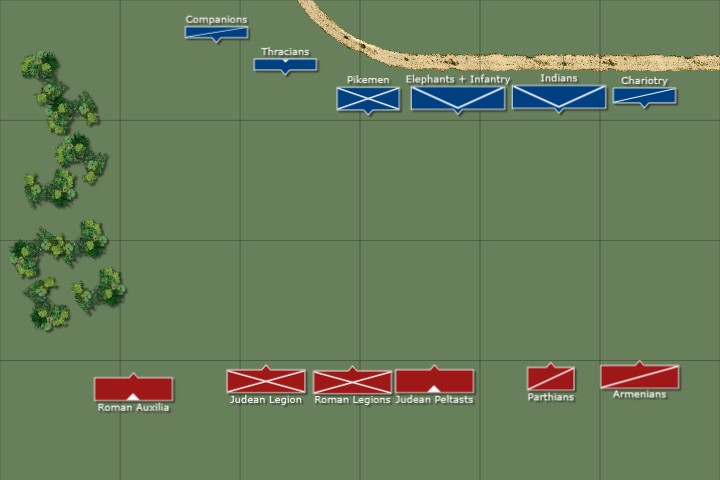
Repeating the same deployment as the previous game, the Roman Alliance appears to have found itself in the same predicament, with the two Cataphract commands facing a wall of Elephants. This time the enemy have refused their right flank with a cautious deployment and so the route is free for the Roman foot to charge forward, although the presence of Alexander's Companions poses a potent threat to the Auxilia in the open. The Legions will have another chance to take on their nemesis - the Phalanx.
On the extreme edges of the known world Armenian cataphracts were looking at an onrushing vehicular tide - Indian Chariotry! A new experience for everyone… much like one might imagine it woudl be to be Welsh, and not have to spell your first name, surname and entire address when speaking to someone in a call centre...
How well do these troops fight then?
Heavy Chariots are the Knights of the Biblical and Classical period, moving more slowly than Cavalry or indeed Light CHariots but packing a punch if they get into combat cleanly. Indian chariots also have the Impetuous ability, giving them an extra factor for Impact at first contact against everyone apart from Spearmen and Pikemen, and the extra damage of Furious Charge against infantry when they win at first contact.
They are however difficult to redeploy, as with Impetous comes Unmaneuverable, so any turns or movements of less than full distance cost extra pips.
Impetuous also leaves them susceptable to making unplanned charges at enemies - once in charge range anything other than a charge costs 3 pips - and with the Indian army only having a Command value of +3 for the entire army, the possibiliity of not having enough pips is never far away.
Heavy Chariots also count as Armoured, and so can go toe-to-toe with armoured foot and Heavy Cavalry in sustained melee, and will generally outlast unarmoured troops.
OK then, so far so "DBM" - but ADLG has one more trick up it's sleeve that means that Heavy Chariots are not just Medieval Knights on square bases. They, along with Medieval Knights and Cataphacts fight most things on a standard +1 factor, but whereas Medieval Knights have a combat factor of +2 against all Mounted, Chariots only have the +2 against Cavalry. So, when they come up against either proper Medieval Knights they are at a disadvantage - and against the high-tech shock troops of the Classical world, Cataphracts, they are on evens but suffer from less effective Armour. So, clearly the Ancients played their battles under ADLG rules, hence the evolution from Chariots to Cataphracts and finally to the Medieval Knight at last makes sense!
Lambs gambolled on the nearby hillsides before being rustled away as in the centre of this battlefield both sides were inching across the table trying to optimise their matchups. With the Parthians facing Elephants they had already decided to attempt a significant redeployment to the opposite side of the table, leaving the Peltasts with the prospect of trying to beat, or at least stand up to the Indian Elephant and Bowmen combo - maybe an interesting possibility given the Inferior-in-Combat nature of the mixed Indian sword/bow units.
The Pike/Legion clash also seemed likely to be tested yet again in this battle - surely a more enduring question than even "Does Gareth Bale ever regret that he's not English..?"
The Thracians and Peltasts were seemingly keen to get into action before the rest of the Indian army could sweep round from their essentially undefended right flank, and so surprised the Elephants by taking the battle to them early doors.
On the other side of the field, the Greek Companion Cavalry were holding back in reserve as the Judean legionaries pushed onwards, outdistancing their supporting Auxilia who were struggling through a wood they had probably expected to find be contested by Indians.
Grabbing almost enough pips the Peltast command split into separate units and all of them made a bee-line for the opposition they thought they might do best against. This could, with good dice, strike a surprisingly effective blow against the Indian command, or at the very least should hold them back and disrupt their formation to slow their otherwise-rapid advance onto the flanks of the legionary assault force.
What's Going on Here Then?
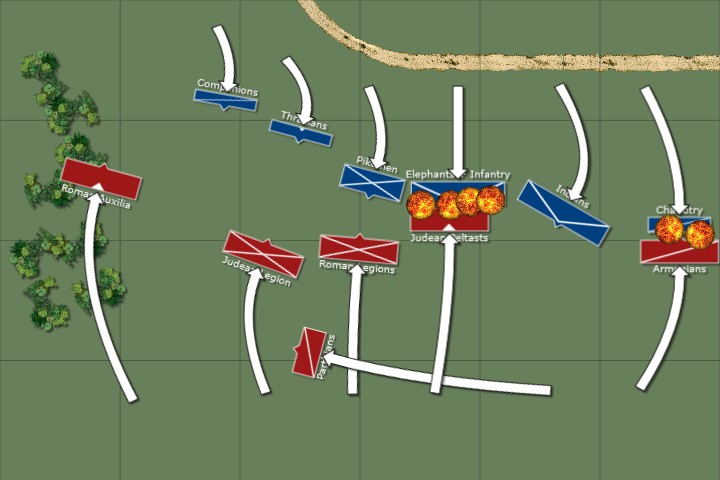
With the Parthians redeploying across almost the full width of the table and the Armenians busy already engaging the Indian Chariotry force the right wing of the Roman alliance is hanging in the breeze as the Indians move up through the gap. The Judean Auxilia have seen a sliver of opportunity to engage the Indians before their envelopment becomes to cloying, and have driven heroically - or suicidally - forward to catch them before their house is in order. The rest of the two armies are teeing themselves up for a Barker-esque clash of civilizations on a diagonal axis as the Romans seek to envelop the cautious defensive stance of the Ino-Greek alliance from the left.
But, Elite Elephants with integral generals are not to be sniffed at, and the brave assault was immediately in trouble after taking a flurry of early-round hits!
Melee proved little better as the Peltasts wilted under he hammer blows of the jubilant Indian forces - the mahouts urged their elephants onwards as they trampled the Greek-style spearmen underfoot, with the Legionaries still some distance away from engaging the Pikemen.
On the extreme right the Armenians were hugging the table edge, looking to bring the Indian Chariotry to road-rage-style battle before the lone Elephant could join in the fray. The Indian long range archers was proving surprisingly effective against the fully armoured horsemen.
Welsh Road Rage
The Legionary line stepped up to the plate as the Greeks readied for impact - and, through the Companions, counterattack!
Gaugamela - and an odd pronunciation
Another Barker-esque battle ensued as the two lines of well drilled foot soldiers clashed under a hail of pilums and javelins shattering on the upraised pikeshafts of the Greek forces.
The Legions needed to resolve their fight quickly and well, as the entire right flank of the Judeao-Roman alliance, denuded of the Parthians, was now barely functioning and barely present.
What's Going on Here Then?
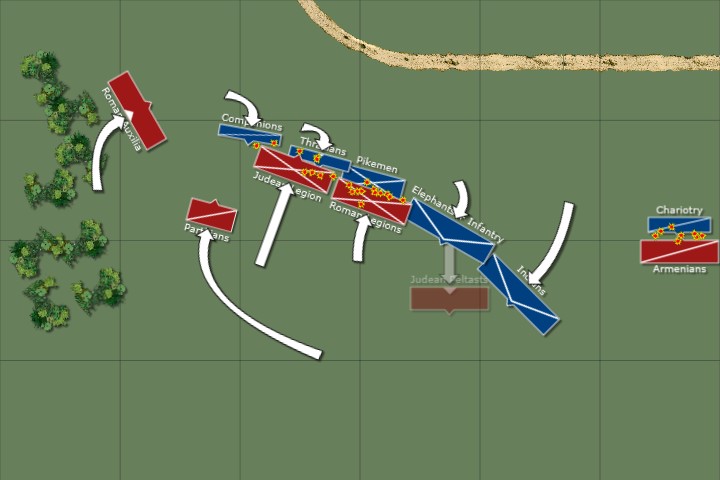
The Judean attack on the elephants has utterly failed, leaving only a few remnants of the Judean Peltast command still in play. On the extreme right a batte is taking place entirely free of context, as the Armenians gradually secure the upper hand against the less well armoured Indian Chariotry - but whoever wins here will be too late to rejoin the main fray. The Parthians have now gotten into a position to contribute to the battle, but waiting for them has slowed the Roman's left hook, and now both sets of Legions are engaged in the centre, trying to force the issue before the Indians sweep them from the table by ploughing into their unguarded right flank.
Those initial combats went well for Rome, with hits springing up on some of the Pikemen and relatively few casualties on the Romans and Judeans.
But, with nothing protecting their right flank the legions soon found themselves coming under punishing flank charges from Indian Infantry, still fresh for the fight after their rather short success against the now-evaporated Thracian and Peltast command.
The Armenians however were proving one of the most vexing Ancients rules conundrums, in terms of how did cavalry evolve to replace chariots when chariots are often classed as Knights - which of course replaced cavalry…? The Armenians had sorted this out simply by use of better die rolls and better armour, making the entire debate moot in a short number of turns.
With the wide open spaces recently vacated by the Peltasts and Parthians calling to them, the Indian commands were sweeping majestically forward in a generally unperturbed fashion.
Big War Elephants!
Equally unperturbed was the Judean Legions advance through the much less dense ranks of the Greek Auxilia facing them - barely a speedbump in the onward march of the Legionary-lite warriors of Judea.
As huge gaps opened up in the Greek lines the Legionaries exercised their textbook Legionary flexible small unit command and control and surrounded the ends of the Greek pike line, providing a compelling reason for the introduction of Imitation Legionaries in later Hellenistic armies
The Armenians were fully intact as they polished off the last of the charioty, leaving the desert-ish-dwelling nomads with full control and mastery of a part of the board from which they were now so far from the rest of the action that their ongoing role in the overall battle was surely now done.
Well, maybe they weren't quite done yet - they still needed to either deal with, or escape the clutches of a rogue elephant!
The Indians had accelerated across the table once fully free of opposition and were soon homing in on the previously rarely seen Roman Walled Baggage Camp.
L'Art de la Guerre hint - a fortified camp is more expensive, and harder to capture than a normal camp - but counts as a greater loss to the overall army morale than a normal camp too. And this one is mandatory in the Roman army
The Pike and Legion battle was becoming a real mess of swirling soldiery, as both sides rolled each other up from opposite ends of the line, committing reserves into the mixer at a rate of knots.
The two sides became increasingly co-mingled as the battle raged back and forth !
What's Going on Here Then?
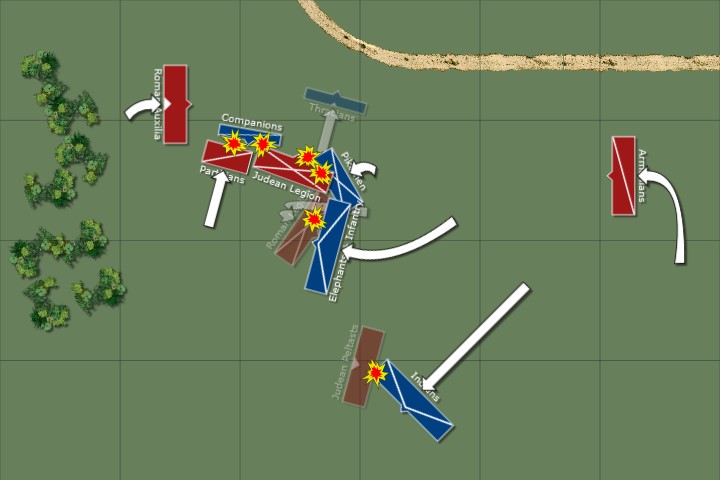
The Roman Legions are a spent force, as the Greek Pikemen, supported by the arrival of an outflanking force of Indian elephants and warriors overwhelm them and take possession of the centre of the field. The Judean Legins have swept away Alexanders Thracians and supported by the fast-arriving Parthians and the outflanking Auxilia are dismembering the Companions - but the Greeks and Indians continue to put pressure on their right flank. One command of Indians has made a bee-line for the Roman baggage, with the ghostly remnants of the Judean Peltast command the only thing in their path to securing a great session of looting.The Armenians have won a great victory against the Indian Chariotry - but, as expected, are now too far from the battle to contribute further.
Had you forgotten about the Parthians? They had also almost forgotten about themselves, but eventually, fully 4 feet from where they started, they reappeared in the front line ready to oppose the cautious Greek Companions - in a far more effective way than the fearful Auxiia could ever hope to do.
The Indians were in the Roman baggage, but were stuck in their efforts to scale the walls as the Judean Lancer Nobles races across the table to try and halt them by stripping away their supporting infantry!
The Armenians were either too brave to run away, or too slow to run away successfully. With one of these things being true they attempted to swarm the Indian elephant and clear the entire flank of the table for their own victory parade.
Hindi-style version of The Chariots of Fire Theme (yes...)!
The Judean Nobles were chewing their way through the poor quality, poorly protected Indian foot whilst the rest of the infantry continued to hack at the palisade to get to the loot within.
With the intervention of the Indians turning out to be decisive, the central Pike block that anchored the Makedonian army had finally gained the upper hand against the Legions of Rome - but even in victory the fight had been too bloody and now they were disorganised and far too exhausted to do much more than breathe a sigh of relief as the Indian elephantry closed in on the last Legion
The Indian general broke off from sacking the baggage to remove the overly-aggressive Judean lancer from the table in short order…
Culturally Appropriate Transport Options from Wargamers Returning Home via Cardiff Central Station
And, with that, the game snuck over the timing finish line ending in a near-defeat for Rome and Judea, but one in which they had inflicted heavy losses on the Alexandrian-Indian alliance - or at least enough losses to keep Alexander and Porus from claiming top prize in the overall event!
Read on for the post match summaries from the Generals involved, as well as another episode of legendary expert analysis from Hannibal
Post Match Summary from the Early Imperial Roman & Judean Commander
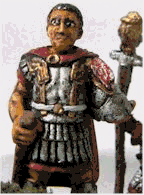 Hmmm... a tricky outing in which the army of a world-conquering hero, and that of his most highly rated and respected opponent in combination did seem to cause my brave boys from Rome and Judea a little more trouble than we hoped would be the case.
Hmmm... a tricky outing in which the army of a world-conquering hero, and that of his most highly rated and respected opponent in combination did seem to cause my brave boys from Rome and Judea a little more trouble than we hoped would be the case.
I will have to go away and carefully recalculate my options here, as it did seem in many of these games that we faced armies that were as large, as wide as ours but which nevertheless had better troops on every inch of frontage - and given my preference for a manly win with frontal combat, that does make things a little more tricky than perhaps I would ideally like. This is clearly a sign of the evolution of the UK ADLG scene into one with competing local "meta's" in which groups of players come up with their own army compositions and tactics, which then enriches the national competition scene as new untried armies are exposed to the light. Hoorah!
As well as rethinking the list choices, I also now see why the much maligned troop type of Javelinmen are perhaps useful in small, well placed numbers as in this game they might well have given the Elephants more pause for thought. Rome must also invest more in inventing torsion artillery and giant cart-borne ballistae, as keeping these Pachyderms at bay is no doubt a good idea.
I will rush off now as I have a podcast to listen to in which various experts discuss whether Elephants are indeed a Super Weapon...
Hannibal's Post Match Analysis
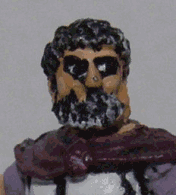 Another near defeat? Is that how this weekend is to end, in a whimper of failure so hapless as to even fail to be spectacular in it's poorness? Looking at this game, in which you repeated not only the deployment, but the tactics and then - of course - the outcome of the previous game against a near-identical opponents makes me fear that you have not the brains of a sleeping two-year-old rocked in the rook of his father's arm!
Another near defeat? Is that how this weekend is to end, in a whimper of failure so hapless as to even fail to be spectacular in it's poorness? Looking at this game, in which you repeated not only the deployment, but the tactics and then - of course - the outcome of the previous game against a near-identical opponents makes me fear that you have not the brains of a sleeping two-year-old rocked in the rook of his father's arm!
The suicidal attack of the Peltasts was, even by your own low standards, a predictable disaster. Setting up to attack a formation such as that is a tricky exercise, but you did so in haste, relying on a good hand of pips at the last minute to reorganise your forces - which, of course, you failed to roll forcing you to engage in combat too soon, and badly deployed. Frankly, wiotnessing that shambles I can draw no conclusion other than that you are the personification of the stench of a low-life latrine!
The Parthians also had to spend pips by the bucketful to get themselves into any sort of useful situation - quite how after 4 games you fail to see that having mounted troops on BOTH wings is a military standard for a very good reason!
I would like to think that you have learnt some chastening lessons at this event, and that foremost among them is that as more and more people take up ADLG, the first-mover advantage that you and your chums once enjoyed is now utterly evaporated, as smarter, quicker, more imaginative - and no doubt more fragrant - warriors than you are compiling lists, thinking through possible opponents, plotting tactics and, most of all, actually practicing far more than you have ever done even on those rare occasions when you have half a brain and a modicum of luck! I hope that some of this will sink in by the next event, but I fear the lessons of history prove this will not be the case at all....
And so, as this weekend draws to a close I am left to wonder, whilst I tell you of your failing, are you still snoring? Is your slack head almost snapped on its stalk, with your face unzipped by the yawns earned in yesterday's debaucheries? Do you have any goals in life? Is there any point to your life?
Add your comments on these reports on the following forums
That's FINALLY the end - so why not go back to the Match Reports Index and read some more reports?
You may also like....
Game 1 Early Imperial Roman & Judean vs Chinese Northern Dynasties & Chi'ang
Game 2 Early Imperial Roman & Judean vs Ostrogoths and Gepids
Game 3 Early Imperial Roman & Judean vs Greco-Indians and Kushans
Game 4 Early Imperial Roman & Judean vs Alexander the Great and Classical Indian
View My Stats for My Match Reports Pages


